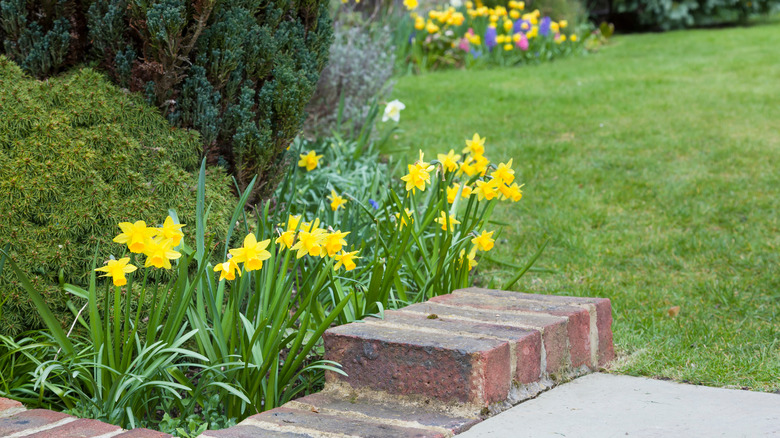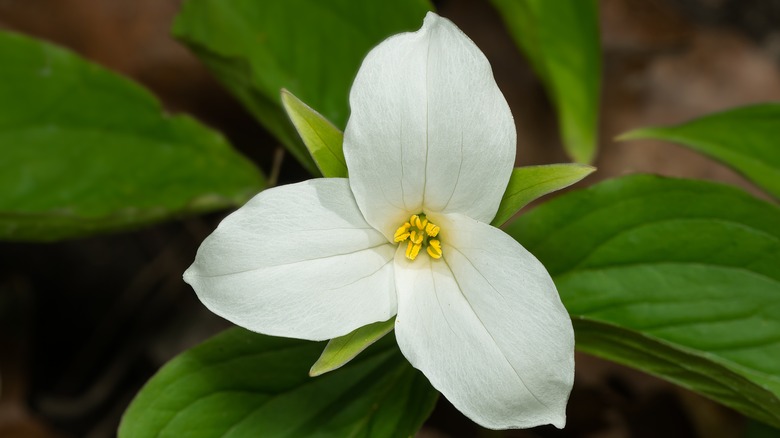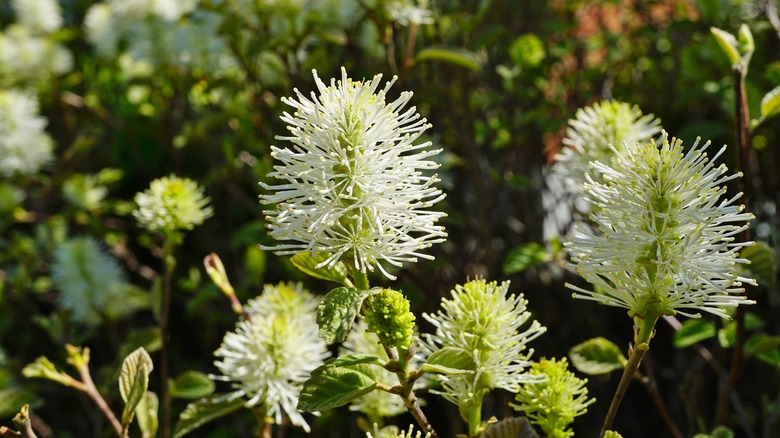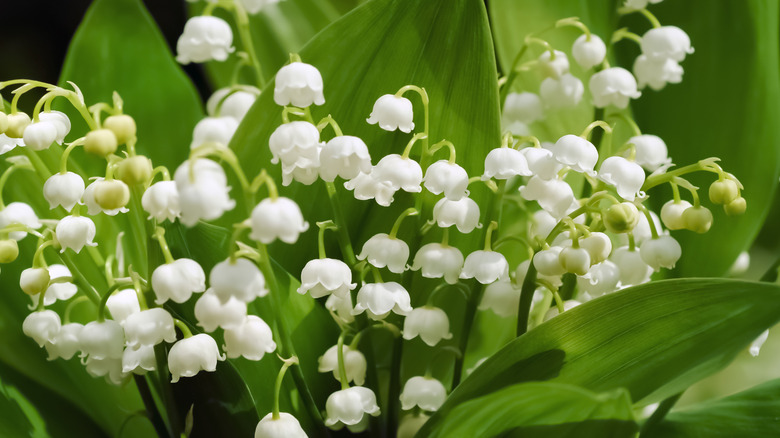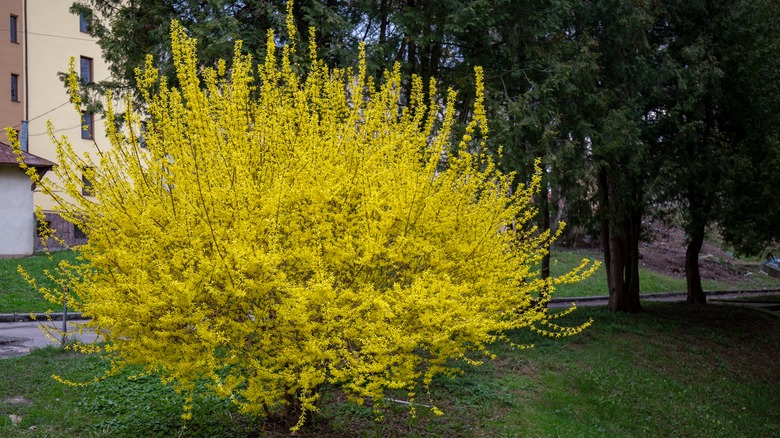15 Colorful Flowers Perfect For Spring Border Gardens
Designing a border garden can be a daunting task. Often, border gardens are filled with several different kinds of plants that have varying maintenance needs. If you don't meet these specifications, or if luck is not on your side, some of your flowering plants won't bloom when you want them to. This can lead to bare spots in your spring garden that should instead be full of flowers. One way to avoid this is to choose flowers that all have the same bloom time with similar care requirements and maintenance schedules.
Before you get too excited about planting any of the following 15 spring flowers and flowering shrubs, keep in mind that you must prepare your border garden first. Taking care of small lawn and garden chores such as clearing away debris, amending your raised beds with soil conditioners, and pruning back large perennials, will help your border garden look its best all season long, advises Proven Winners. It will also help give your plants a better chance at survival with a nutrient-dense home and fewer pests and diseases.
1. Hellebore
The hellebore flower (Helleborus orientalis), sometimes referred to as the Lenten rose, is an early-blooming herbaceous perennial that welcomes spring. As explained by Missouri Botanical Garden, this flower prefers to be planted in a low-light location, such as in a border garden, where it can be shaded by larger plants and shrubs.
Bloom Season: Spring
USDA Growing Zone: 4 to 9
Growing Conditions: Partial to full shade
Soil Type: Moist, rich, and well-draining
Size: 12 to 18 inches tall
2. Bleeding hearts
A bleeding hearts plant (Dicentra spectabilis) is great for border gardens located in the cooler regions of the United States. Designing a spring garden in USDA zones 2 through 6 can be difficult because many beautiful flowers aren't very cold hardy. Luckily, this unique species blooms early and thrives in cold, shady garden beds, as per the University of Wisconsin-Madison.
Bloom Season: Early spring
USDA Growing Zone: 2 to 8
Growing Conditions: Full sun to partial shade
Soil Type: Well-draining, humus-rich clay or sand
Size: 3 feet tall and 4 feet wide
3. Dwarf bearded iris
The dwarf bearded iris (Iris pumila) is a hardy perennial that only grows a little over a foot tall. Varieties of this iris typically bloom in white, blue, or purple. One popular cultivar named 'Larrikin' features dark purple petals with white streaks at the center. Per Romence Gardens and Greenhouses, plant it in the front row of your border.
Bloom Season: Spring and summer
USDA Growing Zone: 4 to 8
Growing Conditions: Sun to partial shade
Soil Type: Fertile and well-draining
Size: 14 inches tall and 6 to 8 inches wide
4. Trillium
Trillium (Trillium spp.) is a wildflower that you may have noticed growing in forests or fields. As mentioned by Longfield Gardens, there are around 40 species of Trillium. Each variety has its own characteristics, but they all feature three-petalled flowers and green leaves that come in sets of three.
Bloom Season: Spring
USDA Growing Zone: 6 to 9
Growing Conditions: Partial shade to full shade
Soil Type: Rich and well-draining
Size: 12 to 18 inches tall
5. Witch-alder
The witch-alder shrub (Fothergilla gardenii) is related to the witch-hazel tree, says the University of Wisconsin-Madison. Like witch-hazel, this is a cold hardy species of shrubs that bloom early in the spring. This plant makes a wonderful flowering backdrop to a border garden filled with other early bloomers.
Bloom Season: Spring
USDA Growing Zone: 4 to 9
Growing Conditions: Full sun
Soil Type: Slightly acidic soil that is rich and well-draining
Size: 3 to 4 feet tall
6. Flowering quince
The flowering quince (Chaenomeles speciosa) is another shrub known for its stems that fill with flowers at the beginning of spring. Per Monrovia, gardeners tend to use hummingbird and butterfly attractor in their mixed borders because they flower plentifully in the spring and turn into lush evergreen backdrops later on in the season.
Bloom Season: Early spring
USDA Growing Zone: 5 to 9
Growing Conditions: Full sun
Soil Type: Moist and well-draining
Size: 3 to 9 feet tall and wide
7. Dutchman's breeches
Dutchman's breeches or britches (Dicentra cucullaria) is a perennial wildflower recognized for its blossoms shaped like flowy, upside-down pants, hence the common name. According to North Carolina State Extension, this flowering plant is best used in border gardens, pollinator gardens, and native gardens.
Bloom Season: Spring
USDA Growing Zone: 3 to 7
Growing Conditions: Dappled sunlight to partial shade
Soil Type: Well-draining, humus-rich, acidic to neutral
Size: 3 to 6 inches tall and 6 to 8 inches wide
8. Lily of the valley
Lily of the valley flowers (Convallaria majalis) are well-known for their fragrant, hanging bell-shaped flowers. Blooming in the early spring, this shade lover is easy to grow and maintain. As explained by Longfield Gardens, the lily of the valley is known to grow in a variety of conditions.
Bloom Season: Early spring
USDA Growing Zone: 3 to 9
Growing Conditions: Partial to full shade
Soil Type: Well-draining
Size: Grows up to 1 foot tall and wide
9. Crocus
Per Missouri Botanical Garden, the European flower, spring crocus (Crocus vernus), blooms for up to three weeks in March. During this blooming period, the flowers have an unusual habit of opening during the daytime and closing during the night or on rainy or cloudy days. The plant is low-maintenance once it's established, and it goes dormant at the end of spring.
Bloom Season: Spring
USDA Growing Zone: 4 to 8
Growing Conditions: Full sun to part shade
Soil Type: Well-draining
Size: 3 to 6 inches tall
10. Pigsqueak
Pigsqueak (Bergenia crassifolia) is a popular evergreen herbaceous perennial that looks great in border gardens, shade gardens, and mass plantings, says North Carolina State Extension. Though the plant's growth rate is slow, these early bloomers will show off their pink-lavender flowers as soon as spring arrives.
Bloom Season: Spring
USDA Growing Zone: 3 to 8
Growing Conditions: Full shade to full sun
Soil Type: Well-draining and organic; clay, loam, or sand
Size: Up to 18 inches tall and 24 inches wide
11. Columbine
Columbine (Aquilegia canadensis) is a pollinator-attracting perennial that tolerates a range of growing conditions, praises Prairie Moon Nursery. The whimsical flowers, which pair well with other spring bloomers such as phlox, Dutchman's breeches, and trillium, blossom in a soft red color with yellow-tipped petals. These flowers give the plant its other common name of 'red columbine.'
Bloom Season: Early spring
USDA Growing Zone: 3 to 8
Growing Conditions: Full sun to partial shade
Soil Type: Well-draining
Size: 2 feet tall
12. Japanese camellia
The broadleaf evergreen shrub, Japanese camellia (Camellia japonica), features red, pink, rose, and white colored flowers. As described by Oregon State University, it can grow quite tall, which makes it perfect for use as a backdrop in a spring border garden. With pruning, the plant's growth habit can become round, rectangular, or hedge-like.
Bloom Season: Early winter to spring
USDA Growing Zone: 7 to 10
Growing Conditions: Full sun to partial shade
Soil Type: Well-draining, moist, and organic
Size: Up to 15 feet tall
13. Daffodil
Daffodils (Narcissus pseudonarcissus) are one of the most popular spring flowers. Most often, they are yellow, but you can also find these bulbs in white, orange, pink, and cream. The blossoms atop stems surrounded by sword-like foliage can last up to 6 weeks. When they begin to fade you can cut off the flower heads, as suggested by Longfield Gardens.
Bloom Season: Early to late spring
USDA Growing Zone: 3 to 8
Growing Conditions: Partial shade or full sun
Soil Type: Well-draining
Size: 6 to 16 inches tall
14. Border forsythia
Border forsythia (Forsythia x intermedia) is a quick-growing shrub that enjoys full sun and alkaline soil. As pointed out by The Morton Arboretum, this species of forsythia is best planted in border gardens where it can show off its yellow flowers that envelop its branches in the early spring.
Bloom Season: Early spring
USDA Growing Zone: 5 to 7
Growing Conditions: Full sun
Soil Type: Well-draining, moist, and alkaline
Size: 3 to 8 feet tall and wide
15. Dwarf flowering almond
Dwarf flowering almond (Prunus glandulosa) is a deciduous shrub regarded for its double flowering blossoms that are typically pink. Other flower colors such as white exist, but they are a rare find, says the University of Arkansas Extension. Add this small shrub to the back of a low-growing spring border garden or move it closer to the front if you plan to add larger shrubs or trees.
Bloom Season: Spring
USDA Growing Zone: 5 to 8
Growing Conditions: Full sun
Soil Type: Rich and well-draining
Size: 3 feet tall and 4 feet wide
